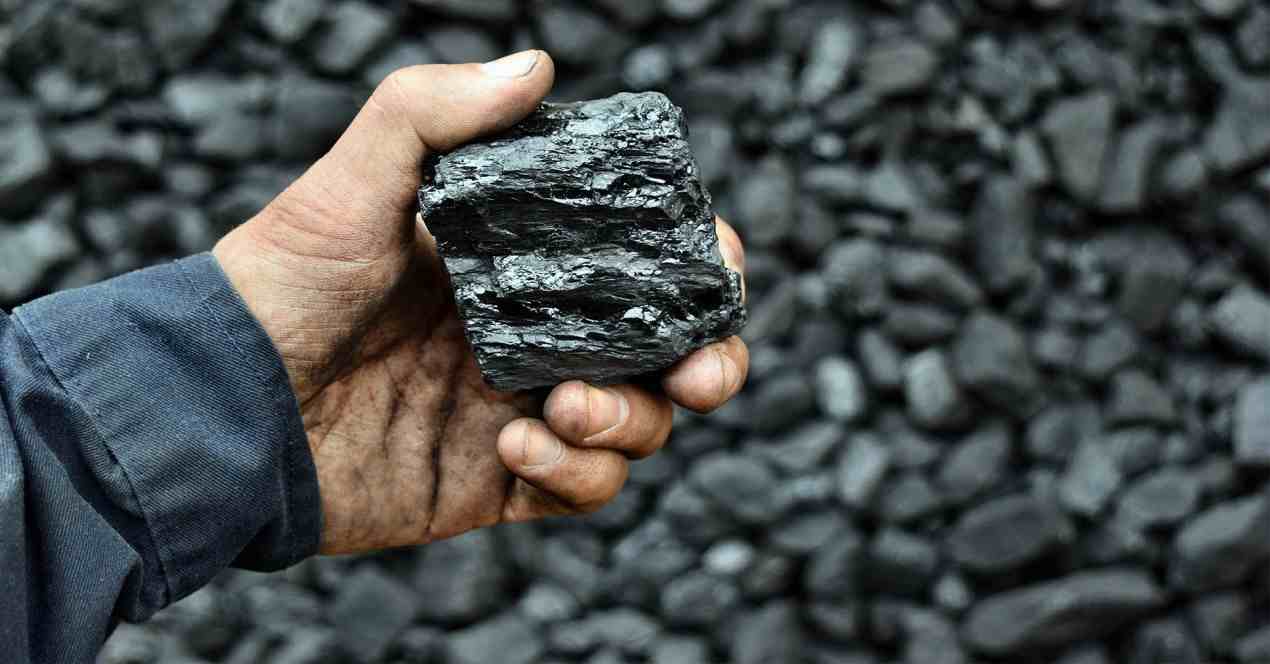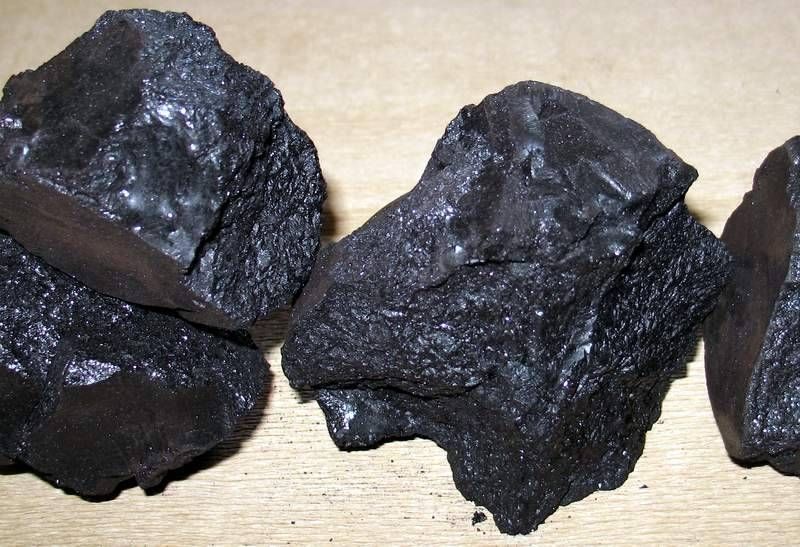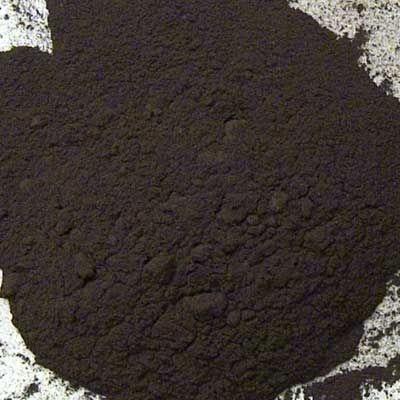
Asphaltum and bitumen are broad terms for many substances based on high-molecular hydrocarbons. From the viewpoint of current art historical research, bitumen represents a large group of organic substances, which consist of an indefinable mixture of high-molecular hydrocarbons. Bitumen either occurs naturally or is obtained from the synthetic distillation of petroleum. Depending upon its place of origin or technique of manufacturing, bitumen possesses a composition of different characteristics.
The English term “bitumen” is used to designate a wide variety of hydrocarbon substances, just as pitch is a term used to designate bituminous substances based on petroleum (such as “glance pitch”) and substances from the sap of trees (such as “Burgundy pitch”). However, the term used in painting usually designated a substance based on hydrocarbons derived from petroleum (at least after the sixteenth century).

Gilsonite ore—a type of asphaltum or bitumen
Asphaltum typically designates a species of bitumen, including dark-colored, comparatively hard, and non-volatile solids; composed of hydrocarbons, substantially free from oxygenated bodies and crystallizable paraffin; sometimes associated with mineral matter, the non-mineral constituents being difficultly fusible and mostly soluble in carbon disulfide; the distillation residue yields considerable sulfonation residue. This definition includes Gilsonite and glances pitch.
In his essay about manuscript painting from 1988, Heinz Roosen-Runge mentions a recipe from a German manuscript of the late fifteenth century, in which bitumen is used to describe an aqueous binding agent for manuscript painting made of a mixture of fish glue and rabbit skin glue. Apparently, this was a typical name for such a binding agent mixture because it is found in another passage in the Neapeler Codex from the fourteenth century and by Valentin Boltz, writing on the same subject in Illuminierbuch (1549). In another example, Zahira Veliz identifies this term in a collection of Spanish and Portuguese treatises of the sixteenth and seventeenth centuries: from a Portuguese manuscript of 1615, the use of bitumen is specified in a varnish for marquetry, which was part of a recipe to make a red lacquer with the pigment and rosin.
It was at one time believed that bitumen was used in the bandages of mummies, but this was generally not the case (instead, balsams were used). Perhaps this error resulted in some confusion, which may have lead individuals to grind actual mummies for use as a pigment, perhaps as an alternative to asphaltum. Of course, the origin of the English word “mummy” is from the Persian or Arabic word “mumia” or “mumiya,” meaning asphaltum or bitumen, which may have caused some confusion about the real source of this pigment.
For further reading on this subject, I recommend the article by Sally Woodcock (1996), “Body Colour: the Misuse of Mummy,” The Conservator, 20.
As an aside, Natural Pigments is trying to obtain Dead Sea or Palestinian bitumen. We have contacted some Jordanian mineral exporters, so we will see what they say in due time. According to sources, Dead Sea bitumen contains less soft hydrocarbons than typical bitumen sources, such as Trinidad. However, our findings show that Gilsonite, or North American Asphaltum, a natural, resinous hydrocarbon found in the Uintah Basin in northeastern Utah, is a very hard substance. This natural asphalt is similar to hard petroleum asphalt and is often called asphaltite, uintaite, or asphaltum.

Gilsonite powder from Natural Pigments
By the way, Natural Pigments offers a pigment known as “mummy” in Russian, so we have kept the use of the name, although it is not from real ground mummies. The text on the Natural Pigments Web site states:
‘Mummy brown is a deep brown color, nearly intermediate in tint between burnt umber and raw umber. A pigment of this color was also prepared from bitumen or asphaltum. In Russia, the term “mummy” has been applied to mineral pigments that exhibited similar characteristics to this pigment. Since we derive our pigment from Russia, we have maintained the use of its name.’
The confusion in ancient times was very great, so the Persians and Arabians used the word “mumiya” to designate bitumen because they believed it was the same substance used by the Egyptians in the wrappings of mummies.
We know something about how the Old Masters used asphaltum in their paintings because we have recipes and references to this pigment. Most likely, there was not one but many different methods by which the Old Masters used this pigment because different forms were available throughout the medieval and Renaissance period. For example, in describing the different forms of bitumen used during this period, Roosen-Runge wrote, ‘One form is bitumen that is equivalent to the modern definition of bitumen, another is bitumen that is a ‘new, as it were, improved bitumen, which dries harder than the usual bitumen,’ and a third is the color collected from mummies.’ (Roosen-Runge, 1967)
Historically, there were two basic methods of preparing asphaltum in oil. One method was to melt the asphaltum in turpentine and mix this liquid with oil, beeswax, and Venice turpentine. Another method was to burn the asphaltum to a cinder (thereby removing most of the easily volatile matter), crush it to a fine powder, and then grind it with a drying oil, typically boiled linseed oil.
Mérimée described the two primary methods for using asphaltum in painting, the first one he attributed to the Italians and the English. This method, which involved dissolving asphaltum in a solvent, such as turpentine, before adding it to oil, would result in paint that lacked body, so many recipes call for adding resin or balsam, such as mastic or Venice turpentine or wax or both types of substances. The second method involved calcining asphaltum to eliminate easily volatilized substances and then grinding it with drying oil, would have body and is more readily usable. Our theory is that the latter form is more durable in oil painting.
Mérimée provides a recipe for the Italian and English methods that includes asphaltum, gum lac, linseed oil, and wax:
‘The gum lac is first dissolved in the turpentine by adding fifteen grains at a time, and allow it to melt before the other portion is added; the asphaltum is then to be mixed in like manner, by degrees; the linseed oil, having been heated near to the boiling point, is also by degrees mingled with the rest; the wax is then added. Before the mixture cools, it should be thrown upon the stone, and well worked with the muller and knife.’ (Mérimée, 1839, p. 182)
Natural Pigments offers powdered asphaltum based on Gilsonite, a natural and harder, less volatile form of bitumen. While it is still soluble in turpentine and mineral spirits, it is much harder than synthetic bitumen.
Although asphaltum has a bad reputation in art history for ruining works of art, there are examples of its use where this is not the case. It may not be so terrible in oil painting, especially with the second preparation method. Natural Pigments will offer Asphaltum as part of Rublev Colours Artist Oils.
Although many aspersions have been cast upon the use of any asphaltum in oil painting, it is interesting to note these comments by Church:
‘The disadvantages attending to the use of these coal-tar browns and of ordinary asphalt are two-fold. Not only are they treacherous on account of their easy fusibility, but they are liable to stain contiguous pigments by reason of their solubility in oil or varnish. When used successfully by the older artists they were always introduced sparingly, or were largely commingled with more solid paints.’ (1901, op. 236)
Church had distinguished between the source of asphaltum earlier in his 1890 edition by endorsing the use of native asphaltum when properly prepared:
‘The operation of roasting native asphalt—keeping it over a slow fire ‘till it will boil no more and becomes nearly a cinder’—was recommended by Williams in his “Essay on the Mechanic of Oil-Colours” (1787), and furnishes a perfectly satisfactory and safe product.’ (1890, p. 208)
Personally, I think asphaltum in oil painting should be revisited, but in carefully controlled and limited circumstances, to determine if it can be employed safely used in modern artworks.
References
Church, A. H. (1890). The Chemistry of Paints and Painting. London: Seeley, Service & Co., Ltd.
Church, A. H. (1901). The Chemistry of Paints and Painting. London: Seeley, Service & Co., Ltd.
Mérimée, J. F. L. (1839). The art of painting in oil, and in fresco; Being a history of the various processes and materials employed, from its discovery, by Hubert and John van Eyck, to the present time. Trans., W. B. Sarsfield Taylor. London: Whitakker & Co.
Roosen-Runge, H. (1967). Farbgebung und Technik frèuhmittelalterlicher Buchmalerei. Studien zu den Traktaten "Mappae Clavicula" und "Heraclius." Mèunchen; Berlin: Deutscher Kunstverlag.
Gilsonite
 A transparent brown to black-brown mineral pigment used in tempera, oil, and watercolor mediums, obtained from natural asphaltum deposits in Utah. Gilsonite, also known as uintahite or asphaltum, is a bitumen-impregnated rock (asphaltite) mainly found in the Uintah Basin of Utah and Colorado, United States. It is a naturally occurring solid hydrocarbon bitumen. Although it also occurs in other locations, its large-scale production occurs only in the Uintah Basin.
A transparent brown to black-brown mineral pigment used in tempera, oil, and watercolor mediums, obtained from natural asphaltum deposits in Utah. Gilsonite, also known as uintahite or asphaltum, is a bitumen-impregnated rock (asphaltite) mainly found in the Uintah Basin of Utah and Colorado, United States. It is a naturally occurring solid hydrocarbon bitumen. Although it also occurs in other locations, its large-scale production occurs only in the Uintah Basin.
Shop Now for
Frequently Asked Questions
What is the use of bitumen paint?
Bitumen paint is a type of coating predominantly used for waterproofing and protective finishing. Its primary application is on materials like concrete, metal, and wood, especially in structures susceptible to moisture. It's also used for rust-proofing, offering a protective, weather-resistant layer.
What is the difference between bitumen and bituminous paint?
Bitumen is a viscous, black, and sticky hydrocarbon substance, whereas bituminous paint is a type of paint formulated from bitumen. Bituminous paint contains bitumen as a base component, mixed with solvents to make it applicable as a protective coating.
Is bitumen paint toxic?
Bitumen paint can emit fumes that may be harmful if inhaled in large quantities or over prolonged periods. It's important to use it in well-ventilated areas and follow safety guidelines. However, once dried, the toxicity significantly reduces.
What is the problem with bitumen paint?
Bitumen paint can be problematic due to its fume emissions during application, potential for skin irritation, and environmental concerns. It’s also less flexible compared to some modern alternatives, which can lead to cracking over time.
Is bitumen harmful to humans?
Bitumen in its solid state is not significantly harmful. However, exposure to fumes during heating or application can be hazardous. Inhaling fumes can lead to respiratory issues, and skin contact should be avoided due to potential irritation.
Is bitumen paint toxic when dry?
Once dried, bitumen paint is generally not toxic. The risk lies primarily in the fumes released during the application process.
Does bitumen have asbestos in it?
Bitumen itself does not contain asbestos. However, in the past, some bitumen-based products, especially in construction, may have included asbestos for added strength and heat resistance. Modern bitumen products are typically asbestos-free.
Is the smell of bitumen toxic?
The smell of bitumen, particularly when hot, is due to the emission of fumes which can contain volatile organic compounds (VOCs). While the odor itself is not toxic, prolonged exposure to these fumes can be harmful.
Is bitumen radioactive?
Bitumen is not inherently radioactive. However, like many natural substances, it may contain trace amounts of naturally occurring radioactive materials (NORMs). The levels are generally low and not considered a health risk.












